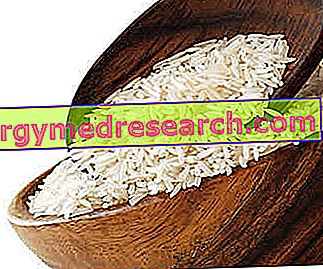Generality
Basmati is a variety of long-grain rice, typical of northern India and Pakistan.

- Typical pandan flavor ( Pandans amaryllifolius : herbaceous plant typical of these areas), thanks to the presence of the aromatic compound 2-acetyl-1-pyrroline ;
- Low glycemic index, due to its chemical and nutritional characteristics.
Basmati Rice and Glycemic Index
According to the Canadian Diabetes Association, cooked basmati rice has a "medium" glycemic index, ranging from 56 to 69.
The glycemic index
The scale of the glycemic index goes from 0 to 100, where the latter represents the standard value referring to a food load of glucose. From 70 upwards, the glycemic index is considered high, while from 55 downwards it is considered low.
Compared to plain white cooked rice, which has a glycemic index of 89, basmati rice is more suited to the diet of diabetics, but also of hypertriglyceridemics and the obese.
It is however necessary to keep in mind that the glycemic index (speed of digestion from food and absorption of glucose) is a characteristic to be subordinated to the glycemic load (ie the total amount of carbohydrates taken with the portion).
In practice, the glycemic index plays a decisive role on the metabolic impact only "with parity" of glycemic load; it would therefore be useless to prefer (for example) a basmati rice compared to a common variety and then abound in the portions.
The INSULIN index
The index and the glycemic load are mainly reflected on the ability to stimulate insulin (anabolic hormone), which is why - in order to estimate the metabolic impact of food - another (theoretically more significant) parameter called index is defined. insulin .
This, which in a certain sense denotes the "fattening" potential of a food, with a constant glycemic load, is inversely proportional to the glycemic index of the food; for this reason, basmati is considered the most suitable variety of rice for slimming diets and nutritional therapy against overweight, type 2 diabetes mellitus, hypertriglyceridemia and the metabolic syndrome.
Basmati Rice with Shrimp and Zucchini
X Problems with video playback? Reload from YouTube Go to Video Page Go to Video Recipes Section Watch the video on youtubeBackground
The term "Basmati" comes from the word "vasmati", which in Sanskrit means "fragrant".
It is hypothesized that basmati rice was initially cultivated in the Indian subcontinent for many centuries; the first written testimony can be traced back to the book Heer Ranjha, dated 1766 AD. The food was then exported to the Middle East by Indian traders. This is why, to date, basmati rice is not only a fundamental ingredient of Indo-Pakistani cuisine, but also of Persian, Arab and many others in the surrounding area.
India and Pakistan are the only producers and exporters of basmati rice.
Production and Cultivation
The Indian areas of basmati rice production are the states of Madhya Pradesh, Punjab, Haryana, Rajasthan, Jammu & Kashmir, Himachal Pradesh, Delhi, Uttaranchal, Uttar Pradesh and Bihar. The total Indian production for the year 2011-2012, concluded in June, was 5 million tons. Haryana is the main place, where 60% of national production is exceeded.
In Pakistan, 95% of the cultivation of basmati rice takes place in the province of Punjab, where the total production of the year 2010 was 2.47 million tons.
Varieties and Hybrids
There are many varieties of basmati rice.
Traditional Indian types include: basmati 370, basmati 385 and basmati Ranbirsinghpura (RSPura). The Pakistani cultivars are: PK 385, 1121 Extra Long Grain Rice, super Kernel Basmati Rise and D-98.
Indian scientists from the Agricultural Research Institute of Delhi have produced a hybrid with "dwarf" seeds, which has improved various characteristics compared to the original one; among these: seed elongation, aroma and alkaline content. The product was called Pusa Basmati-1 (PB1, also known as Todal) and boasts a cultivation yield up to 200% compared to the initial type.
From this Species also the scented rice derives, although they do not constitute varieties in their own right; among these are PB2 (also called Sugandh-2), PB3 and RS-10.
The Indian types approved as basmati are: Dehradun, P3 Punjab, Uttar Pradesh type III, Safidon hbc -19, Haryana 386, Kasturi (Baran, Rajasthan), Basmati 198, Basmati 217, Basmati 370, Bihar, Kasturi, Mahi Suganda, Pusa (duplicate basmati) and 1121.
The Pakistani ones are: Basmati 370 (Pakki Basmati), Super Basmati (Kachi Basmati), Basmati Cannabis, Basmati Pak (Kernal), Basmati 385, Basmati 515, Basmati 2000 and Basmati 198.
In the United States, there is a variety of rice derived from basmati called Texmati, while in Kenya another one is called Pishori or Pisori (cultivated in the region of Mwea).
Basmati Rice and Adulteration
The difficulty in differentiating the types of basmati "properly so called" from the others, and the significant difference in price (greater in basmati), led the fraudulent operators to adultery with crossed varieties and / or other long-grain rice.
In Britain, in 2005, the "Food Standards Agency" discovered that about half of all commercialized basmati rice was adulterated with other long-grain rice strains, prompting importers to sign a code of conduct.
In 2010, in the United Kingdom, tests on rice supplied by wholesalers revealed that as many as 4 samples out of 15 contained cheaper rice mixed with basmati, while 1 was even devoid of the declared variety; the other 10 were in accordance with the law.
A PCR test based on the genetic footprint allows the identification of adulterated and healthy strains; the detection limit is 1% upwards and the error rate corresponds to ± 1.5%. Basmati rice exporters use this genetic analysis to define a "purity certification" to be attributed to their basmati rice shipments. Based on this protocol, which was developed at the "Center for DNA Fingerprinting and Diagnostics", the Indian company "Labindia" has made detection kits available to identify any load sophistication.
Battle of Patents on Basmati Rice
In September 1997, at the "RiceTec", a Texan company, the "American Patent" n. 5, 663, 484 for "basmati rice lines and grains". This patent protects basmati lines, similar lines and related analytical methods of the company.
RiceTec, owned by Prince Hans-Adam, a native of Liechtenstein, then faced international indignation and the charge for bio-piracy. The circumstance resulted in a (albeit brief) diplomatic crisis between India and the United States, with India threatening to cite the issue to the "World Trade Organization" (WTO) blaming the United States and RiceTec for the violation of agreements on commercial and intellectual property rights (TRIDs).
RiceTec has consequently withdrawn most of the claims on the patent, including, above all, the right to call their rice lines as "Basmati".
In 2001 the multinational was then granted a patent limited to the three varieties of rice developed by the company (not basmati).



